
Lecture 3: Association rules and frequent sequence mining¶
Quan Nguyen, Department of Statistics, University of British Columbia
1. Introduction to association rules mining¶
Association rules look for combination of items that frequently occur together in transactions (a.k.a. frequent set items). For example, retail basket analysis is one of the most common applications of association rules. By finding frequent itemsets, retailers could understand what is commonly bought together and use this information to increase sales in various ways (e.g., place frequently bought together items next to each other in a store).
Transaction_ID |
items |
|---|---|
1 |
milk, bread |
2 |
bread, butter |
3 |
beer, avocado, pizza |
4 |
milk, bread, butter |
5 |
bread, butter |
What is an example of a frequent itemset from the table above?
How can association rules be applied in education?
If we take the analogy of a market basket analysis, each student is a ‘customer’ and in each semester, they will make a ‘transaction’ by enrolling in a set of courses. The data will often take the forms of term_ID,student_ID, and course_ID.
term_ID |
student_ID |
course_ID |
|---|---|---|
1 |
Quan |
STAT_101 |
1 |
Quan |
PSY_101 |
1 |
Quan |
ECON_101 |
2 |
Quan |
STAT_201 |
2 |
Quan |
CS_101 |
2 |
Quan |
POL_101 |
1 |
Chris |
CS_101 |
1 |
Chris |
MATH_101 |
1 |
Chris |
PSY_101 |
2 |
Chris |
CS_201 |
2 |
Chris |
STAT_101 |
Similar data but in a different format
term_ID |
student_ID |
transaction_ID |
course_ID_set |
|---|---|---|---|
1 |
Quan |
1 |
STAT_101, PSY_101, ECON_101 |
2 |
Quan |
2 |
STAT_201, CS_101, POL_101 |
1 |
Chris |
3 |
CS_101, MATH_101, PSY_101 |
2 |
Chris |
4 |
CS_201, STAT_101 |
Using the information available in the Student Information Systems (SIS), we can answer research questions such as:
Which set of courses are often taken together? -> A-priori algorithm
Which set of courses are often taken following a set of courses? -> SPADE algorithm
What are the limitations of association rules?
Note that association rules only focus on the most frequent (popular) items, and it misses out all the information that are present in the “long tail” of user preference that are essential to provide customized recommendations to customers/users. In such scenarioes, other recommender systems such as collaborative filtering (i.e. recommendations based on user similarity) or content-based filtering (i.e., recommendations based on item similarity) will help detect customers with similar interests even if the absolute number of transactions is small (e.g., customer who are interested in a niche category).
library(tidyverse)
library(arules)
library(arulesViz)
library(arulesSequences)
── Attaching packages ──────────────────────────────────────────────────────────────────────────── tidyverse 1.3.1 ──
✔ ggplot2 3.3.5 ✔ purrr 0.3.4
✔ tibble 3.1.5 ✔ dplyr 1.0.7
✔ tidyr 1.1.3 ✔ stringr 1.4.0
✔ readr 2.0.1 ✔ forcats 0.5.1
Warning message:
“package ‘tibble’ was built under R version 4.1.1”
Warning message:
“package ‘readr’ was built under R version 4.1.1”
── Conflicts ─────────────────────────────────────────────────────────────────────────────── tidyverse_conflicts() ──
✖ dplyr::filter() masks stats::filter()
✖ dplyr::lag() masks stats::lag()
Warning message:
“package ‘arules’ was built under R version 4.1.1”
Loading required package: Matrix
Attaching package: ‘Matrix’
The following objects are masked from ‘package:tidyr’:
expand, pack, unpack
Attaching package: ‘arules’
The following object is masked from ‘package:dplyr’:
recode
The following objects are masked from ‘package:base’:
abbreviate, write
Warning message:
“package ‘arulesViz’ was built under R version 4.1.1”
Attaching package: ‘arulesSequences’
The following object is masked from ‘package:arules’:
itemsets
Let’s create a sythetic dataset
df <- data.frame(matrix(ncol = 2, nrow = 1000))
colnames(df) <- c("id","course")
set.seed(123)
df$id <- sample(x=1:250,1000,replace = T)
set.seed(123)
df$course <- sample(x=c("PSY","MATH","STATS","ECON","PHY","ENG","POLS","BIO","CHEM"),1000,replace=T)
df <- df %>% distinct() %>% arrange(id)
head(df)
| id | course | |
|---|---|---|
| <int> | <chr> | |
| 1 | 1 | POLS |
| 2 | 2 | ECON |
| 3 | 2 | MATH |
| 4 | 2 | STATS |
| 5 | 3 | ECON |
| 6 | 4 | BIO |
Let’s transform this data frame into transaction format
df <- df %>% group_by(id) %>%
summarise(courselist = paste0(course, collapse = ","),count = n())
head(df)
| id | courselist | count |
|---|---|---|
| <int> | <chr> | <int> |
| 1 | POLS | 1 |
| 2 | ECON,MATH,STATS | 3 |
| 3 | ECON | 1 |
| 4 | BIO,PHY,CHEM,ENG | 4 |
| 5 | PSY,BIO | 2 |
| 6 | ENG,BIO | 2 |
# convert to transaction data object
df$courselist <- as.factor(df$courselist)
# export to csv
write.csv(df$courselist,"course.csv", row.names = FALSE, col.names = FALSE, quote = FALSE)
# read in the csv file
df_obj <- read.transactions('course.csv', format = 'basket', sep=',')
df_obj
Warning message in write.csv(df$courselist, "course.csv", row.names = FALSE, col.names = FALSE, :
“attempt to set 'col.names' ignored”
transactions in sparse format with
247 transactions (rows) and
10 items (columns)
2. Association measures¶
Support¶
The support metric tells us how popular a set of items is relative to the total number of transactions
itemFrequencyPlot(df_obj,topN=20,type="relative", main="Relative Item Frequency Plot")

Confidence¶
The confidence metric tells us how likely an item Y is purchased given item X is purchased.
confidence = P(X,Y) / P(X)
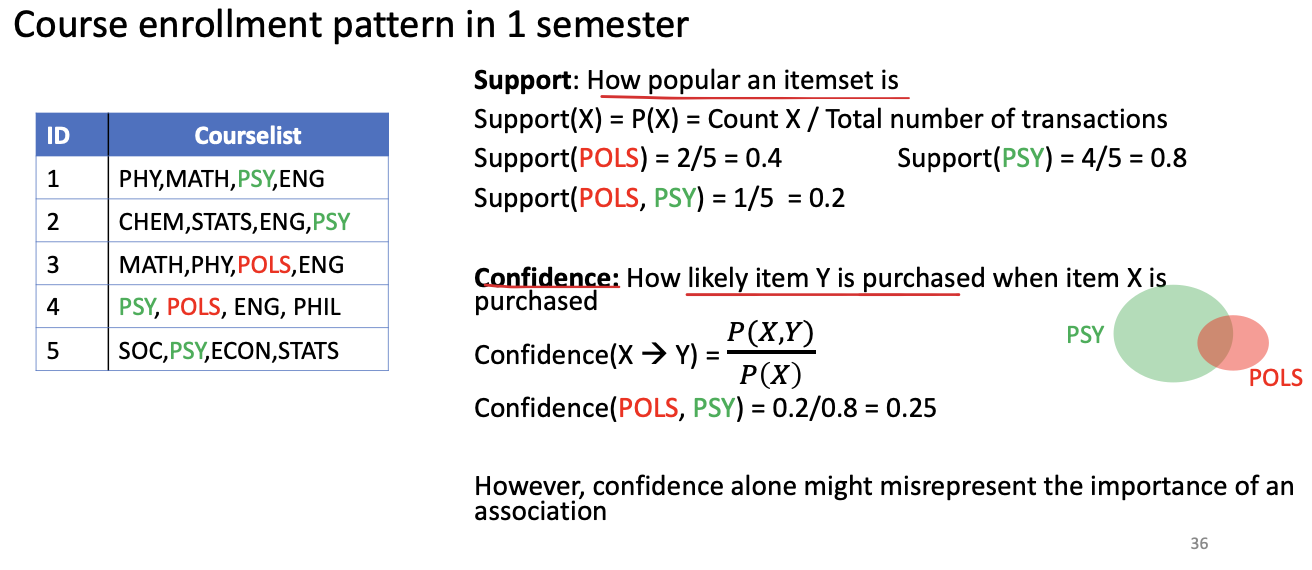
Note that the confidence measure might misrepresent the importance of an association. This is because it only accounts for how popular item X is (in our case PSY) but not Y (in our case POLS).
If beer is also very popular in general, there will be a higher chance that a transaction containing PSY will also contain POLS, thus inflating the confidence measure. To account for the base popularity of both items, we use a third measure called lift.
Lift¶
Lift tells us how likely item Y is purchased when item X is purchased, while controlling for how popular items Y and X are

lift = 1: implies no association between items.
lift > 1: greater than 1 means that item Y is likely to be bought if item X is bought,
lift < 1: less than 1 means that item Y is unlikely to be bought if item X is bought.
3. A-priori algorithm with arules¶
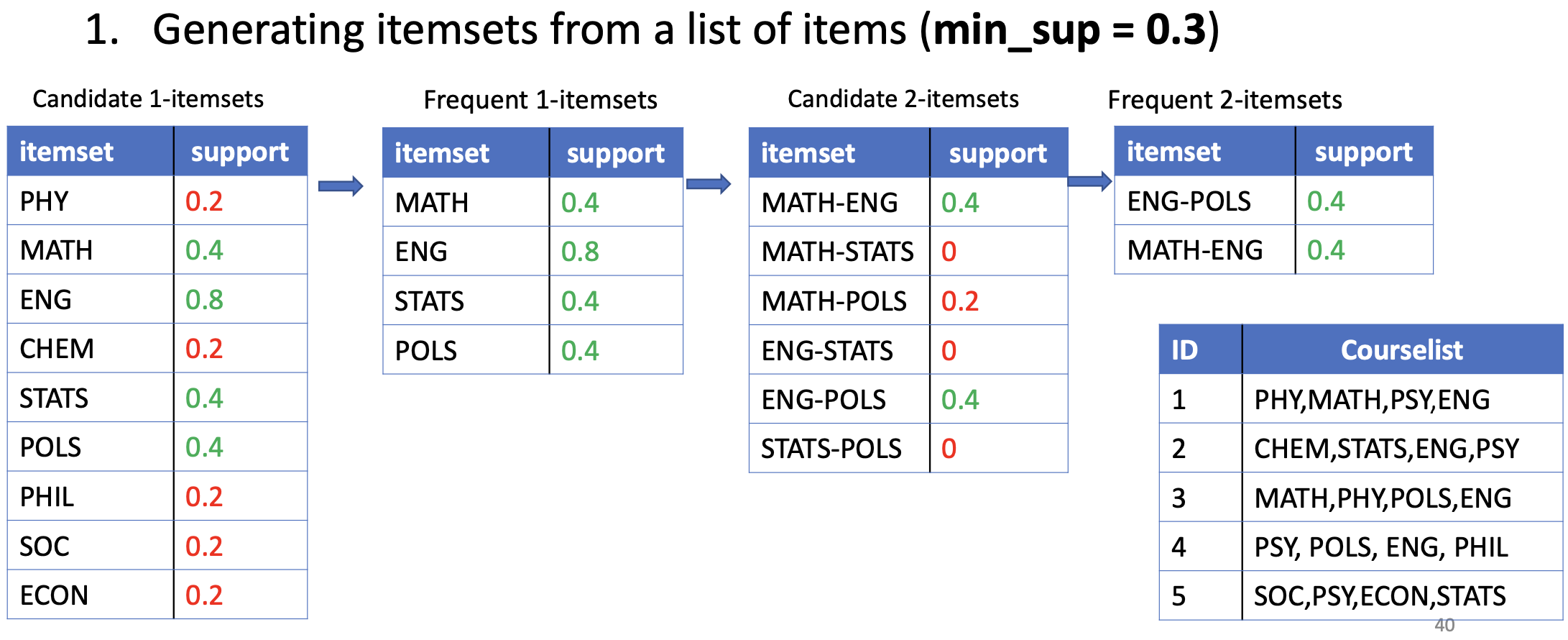
association.rules <- apriori(df_obj, parameter = list(supp=0.02, conf=0.6,maxlen=6))
Apriori
Parameter specification:
confidence minval smax arem aval originalSupport maxtime support minlen
0.6 0.1 1 none FALSE TRUE 5 0.02 1
maxlen target ext
6 rules TRUE
Algorithmic control:
filter tree heap memopt load sort verbose
0.1 TRUE TRUE FALSE TRUE 2 TRUE
Absolute minimum support count: 4
set item appearances ...[0 item(s)] done [0.00s].
set transactions ...[10 item(s), 247 transaction(s)] done [0.00s].
sorting and recoding items ... [9 item(s)] done [0.00s].
creating transaction tree ... done [0.00s].
checking subsets of size 1 2 3 4 done [0.00s].
writing ... [19 rule(s)] done [0.00s].
creating S4 object ... done [0.00s].
inspect(association.rules[1:10])
lhs rhs support confidence coverage lift
[1] {MATH, PHY} => {CHEM} 0.06882591 0.6800000 0.10121457 1.646667
[2] {ECON, ENG, MATH} => {STATS} 0.02429150 0.6000000 0.04048583 1.610870
[3] {ENG, MATH, STATS} => {ECON} 0.02429150 0.6000000 0.04048583 1.807317
[4] {ENG, MATH, PHY} => {CHEM} 0.02429150 0.7500000 0.03238866 1.816176
[5] {ECON, MATH, PHY} => {CHEM} 0.02024291 0.7142857 0.02834008 1.729692
[6] {BIO, ECON, MATH} => {PSY} 0.02024291 0.6250000 0.03238866 1.882622
[7] {MATH, PSY, STATS} => {ECON} 0.02024291 0.6250000 0.03238866 1.882622
[8] {MATH, PHY, PSY} => {CHEM} 0.02429150 0.7500000 0.03238866 1.816176
[9] {CHEM, MATH, PSY} => {PHY} 0.02429150 0.6666667 0.03643725 1.937255
[10] {MATH, PHY, STATS} => {CHEM} 0.02024291 0.7142857 0.02834008 1.729692
count
[1] 17
[2] 6
[3] 6
[4] 6
[5] 5
[6] 5
[7] 5
[8] 6
[9] 6
[10] 5
# Finding Rules related to given items
# Find what students enrolled before choosing 'ECON'
item.association.rules <- apriori(df_obj, parameter = list(supp=0.02, conf=0.6),
appearance = list(default="lhs",rhs="ECON"))
Apriori
Parameter specification:
confidence minval smax arem aval originalSupport maxtime support minlen
0.6 0.1 1 none FALSE TRUE 5 0.02 1
maxlen target ext
10 rules TRUE
Algorithmic control:
filter tree heap memopt load sort verbose
0.1 TRUE TRUE FALSE TRUE 2 TRUE
Absolute minimum support count: 4
set item appearances ...[1 item(s)] done [0.00s].
set transactions ...[10 item(s), 247 transaction(s)] done [0.00s].
sorting and recoding items ... [9 item(s)] done [0.00s].
creating transaction tree ... done [0.00s].
checking subsets of size 1 2 3 4 done [0.00s].
writing ... [2 rule(s)] done [0.00s].
creating S4 object ... done [0.00s].
inspect(head(item.association.rules))
lhs rhs support confidence coverage lift
[1] {ENG, MATH, STATS} => {ECON} 0.02429150 0.600 0.04048583 1.807317
[2] {MATH, PSY, STATS} => {ECON} 0.02024291 0.625 0.03238866 1.882622
count
[1] 6
[2] 5
# Find what students enrolled after choosing 'MATH' and 'PHY'
item2.association.rules <- apriori(df_obj, parameter = list(supp=0.02, conf=0.6),
appearance = list(default="rhs",lhs=c("MATH","PHY")))
inspect(head(item2.association.rules))
Apriori
Parameter specification:
confidence minval smax arem aval originalSupport maxtime support minlen
0.6 0.1 1 none FALSE TRUE 5 0.02 1
maxlen target ext
10 rules TRUE
Algorithmic control:
filter tree heap memopt load sort verbose
0.1 TRUE TRUE FALSE TRUE 2 TRUE
Absolute minimum support count: 4
set item appearances ...[2 item(s)] done [0.00s].
set transactions ...[10 item(s), 247 transaction(s)] done [0.00s].
sorting and recoding items ... [9 item(s)] done [0.00s].
creating transaction tree ... done [0.00s].
checking subsets of size 1 2 3 done [0.00s].
writing ... [1 rule(s)] done [0.00s].
creating S4 object ... done [0.00s].
lhs rhs support confidence coverage lift count
[1] {MATH, PHY} => {CHEM} 0.06882591 0.68 0.1012146 1.646667 17
plot(association.rules)
# plot(association.rules, engine = "plotly")
To reduce overplotting, jitter is added! Use jitter = 0 to prevent jitter.
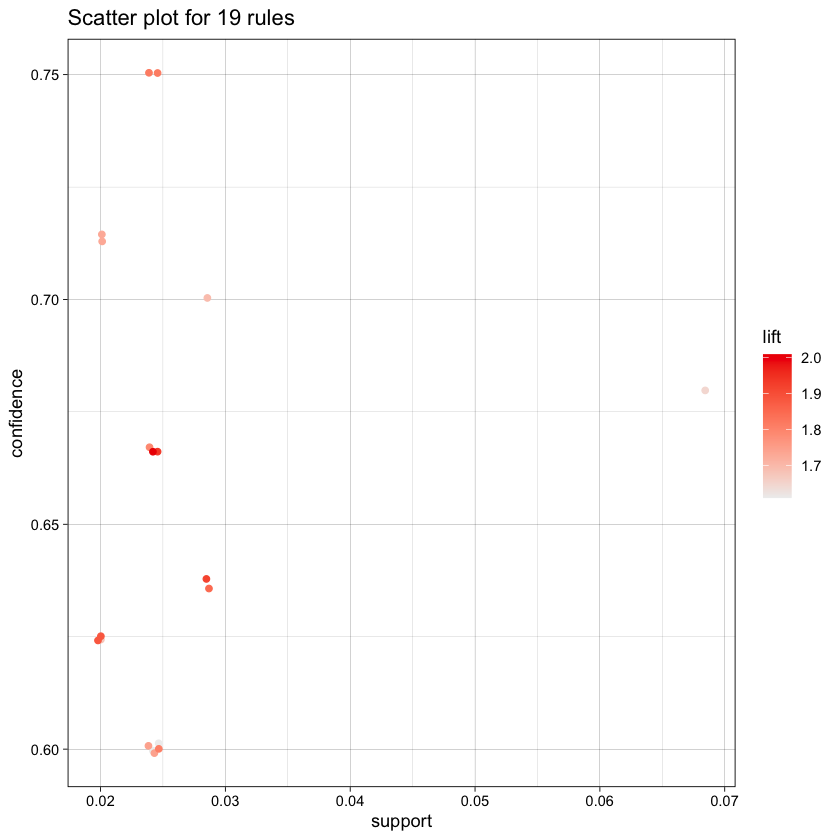
There is a special value for shading called “order” which produces a two-key plot where the color of the points represents the length (order)
plot(association.rules,method="two-key plot")
To reduce overplotting, jitter is added! Use jitter = 0 to prevent jitter.

Graph-based techniques concentrate on the relationship between individual items in the rule set. They represent the rules (or itemsets) as a graph with items as labeled vertices, and rules (or itemsets) represented as vertices connected to items using arrows.
For rules, the LHS items are connected with arrows pointing to the vertex representing the rule and the RHS has an arrow pointing to the item.
plot(association.rules, method = "graph")
# plot(association.rules, method = "graph", engine = "htmlwidget")
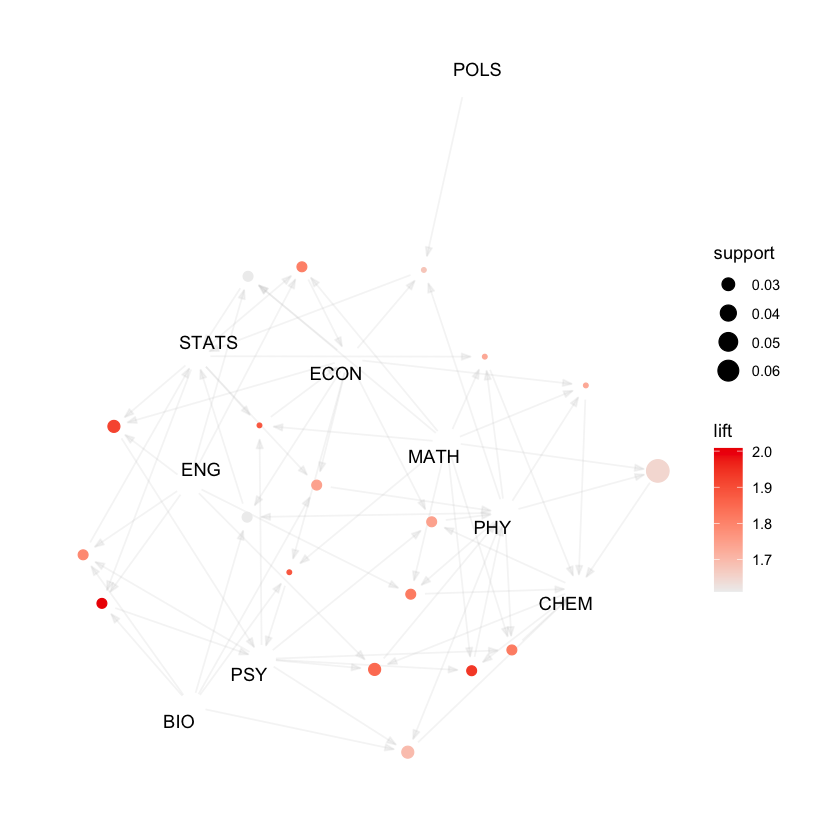
# Parallel plot
plot(association.rules, method="paracoord")

Let’s try a-priori with different levels of support
# Support and confidence values
supportLevels <- c(0.1, 0.05, 0.01, 0.005)
confidenceLevels <- c(0.9, 0.8, 0.7, 0.6, 0.5, 0.4, 0.3, 0.2, 0.1)
# Empty integers
rules_sup10 <- integer(length=9)
rules_sup5 <- integer(length=9)
rules_sup1 <- integer(length=9)
rules_sup0.5 <- integer(length=9)
# Apriori algorithm with a support level of 10%
for (i in 1:length(confidenceLevels)) {
rules_sup10[i] <- length(apriori(df_obj, parameter=list(sup=supportLevels[1],
conf=confidenceLevels[i], target="rules")))
}
# Apriori algorithm with a support level of 5%
for (i in 1:length(confidenceLevels)){
rules_sup5[i] <- length(apriori(df_obj, parameter=list(sup=supportLevels[2],
conf=confidenceLevels[i], target="rules")))
}
# Apriori algorithm with a support level of 1%
for (i in 1:length(confidenceLevels)){
rules_sup1[i] <- length(apriori(df_obj, parameter=list(sup=supportLevels[3],
conf=confidenceLevels[i], target="rules")))
}
# Apriori algorithm with a support level of 0.5%
for (i in 1:length(confidenceLevels)){
rules_sup0.5[i] <- length(apriori(df_obj, parameter=list(sup=supportLevels[4],
conf=confidenceLevels[i], target="rules")))
}
Apriori
Parameter specification:
confidence minval smax arem aval originalSupport maxtime support minlen
0.9 0.1 1 none FALSE TRUE 5 0.1 1
maxlen target ext
10 rules TRUE
Algorithmic control:
filter tree heap memopt load sort verbose
0.1 TRUE TRUE FALSE TRUE 2 TRUE
Absolute minimum support count: 24
set item appearances ...[0 item(s)] done [0.00s].
set transactions ...[10 item(s), 247 transaction(s)] done [0.00s].
sorting and recoding items ... [9 item(s)] done [0.00s].
creating transaction tree ... done [0.00s].
checking subsets of size 1 2 3 done [0.00s].
writing ... [0 rule(s)] done [0.00s].
creating S4 object ... done [0.00s].
Apriori
Parameter specification:
confidence minval smax arem aval originalSupport maxtime support minlen
0.8 0.1 1 none FALSE TRUE 5 0.1 1
maxlen target ext
10 rules TRUE
Algorithmic control:
filter tree heap memopt load sort verbose
0.1 TRUE TRUE FALSE TRUE 2 TRUE
Absolute minimum support count: 24
set item appearances ...[0 item(s)] done [0.00s].
set transactions ...[10 item(s), 247 transaction(s)] done [0.00s].
sorting and recoding items ... [9 item(s)] done [0.00s].
creating transaction tree ... done [0.00s].
checking subsets of size 1 2 3 done [0.00s].
writing ... [0 rule(s)] done [0.00s].
creating S4 object ... done [0.00s].
Apriori
Parameter specification:
confidence minval smax arem aval originalSupport maxtime support minlen
0.7 0.1 1 none FALSE TRUE 5 0.1 1
maxlen target ext
10 rules TRUE
Algorithmic control:
filter tree heap memopt load sort verbose
0.1 TRUE TRUE FALSE TRUE 2 TRUE
Absolute minimum support count: 24
set item appearances ...[0 item(s)] done [0.00s].
set transactions ...[10 item(s), 247 transaction(s)] done [0.00s].
sorting and recoding items ... [9 item(s)] done [0.00s].
creating transaction tree ... done [0.00s].
checking subsets of size 1 2 3 done [0.00s].
writing ... [0 rule(s)] done [0.00s].
creating S4 object ... done [0.00s].
Apriori
Parameter specification:
confidence minval smax arem aval originalSupport maxtime support minlen
0.6 0.1 1 none FALSE TRUE 5 0.1 1
maxlen target ext
10 rules TRUE
Algorithmic control:
filter tree heap memopt load sort verbose
0.1 TRUE TRUE FALSE TRUE 2 TRUE
Absolute minimum support count: 24
set item appearances ...[0 item(s)] done [0.00s].
set transactions ...[10 item(s), 247 transaction(s)] done [0.00s].
sorting and recoding items ... [9 item(s)] done [0.00s].
creating transaction tree ... done [0.00s].
checking subsets of size 1 2 3 done [0.00s].
writing ... [0 rule(s)] done [0.00s].
creating S4 object ... done [0.00s].
Apriori
Parameter specification:
confidence minval smax arem aval originalSupport maxtime support minlen
0.5 0.1 1 none FALSE TRUE 5 0.1 1
maxlen target ext
10 rules TRUE
Algorithmic control:
filter tree heap memopt load sort verbose
0.1 TRUE TRUE FALSE TRUE 2 TRUE
Absolute minimum support count: 24
set item appearances ...[0 item(s)] done [0.00s].
set transactions ...[10 item(s), 247 transaction(s)] done [0.00s].
sorting and recoding items ... [9 item(s)] done [0.00s].
creating transaction tree ... done [0.00s].
checking subsets of size 1 2 3 done [0.00s].
writing ... [0 rule(s)] done [0.00s].
creating S4 object ... done [0.00s].
Apriori
Parameter specification:
confidence minval smax arem aval originalSupport maxtime support minlen
0.4 0.1 1 none FALSE TRUE 5 0.1 1
maxlen target ext
10 rules TRUE
Algorithmic control:
filter tree heap memopt load sort verbose
0.1 TRUE TRUE FALSE TRUE 2 TRUE
Absolute minimum support count: 24
set item appearances ...[0 item(s)] done [0.00s].
set transactions ...[10 item(s), 247 transaction(s)] done [0.00s].
sorting and recoding items ... [9 item(s)] done [0.00s].
creating transaction tree ... done [0.00s].
checking subsets of size 1 2 3 done [0.00s].
writing ... [12 rule(s)] done [0.00s].
creating S4 object ... done [0.00s].
Apriori
Parameter specification:
confidence minval smax arem aval originalSupport maxtime support minlen
0.3 0.1 1 none FALSE TRUE 5 0.1 1
maxlen target ext
10 rules TRUE
Algorithmic control:
filter tree heap memopt load sort verbose
0.1 TRUE TRUE FALSE TRUE 2 TRUE
Absolute minimum support count: 24
set item appearances ...[0 item(s)] done [0.00s].
set transactions ...[10 item(s), 247 transaction(s)] done [0.00s].
sorting and recoding items ... [9 item(s)] done [0.00s].
creating transaction tree ... done [0.00s].
checking subsets of size 1 2 3 done [0.00s].
writing ... [74 rule(s)] done [0.00s].
creating S4 object ... done [0.00s].
Apriori
Parameter specification:
confidence minval smax arem aval originalSupport maxtime support minlen
0.2 0.1 1 none FALSE TRUE 5 0.1 1
maxlen target ext
10 rules TRUE
Algorithmic control:
filter tree heap memopt load sort verbose
0.1 TRUE TRUE FALSE TRUE 2 TRUE
Absolute minimum support count: 24
set item appearances ...[0 item(s)] done [0.00s].
set transactions ...[10 item(s), 247 transaction(s)] done [0.00s].
sorting and recoding items ... [9 item(s)] done [0.00s].
creating transaction tree ... done [0.00s].
checking subsets of size 1 2 3 done [0.00s].
writing ... [81 rule(s)] done [0.00s].
creating S4 object ... done [0.00s].
Apriori
Parameter specification:
confidence minval smax arem aval originalSupport maxtime support minlen
0.1 0.1 1 none FALSE TRUE 5 0.1 1
maxlen target ext
10 rules TRUE
Algorithmic control:
filter tree heap memopt load sort verbose
0.1 TRUE TRUE FALSE TRUE 2 TRUE
Absolute minimum support count: 24
set item appearances ...[0 item(s)] done [0.00s].
set transactions ...[10 item(s), 247 transaction(s)] done [0.00s].
sorting and recoding items ... [9 item(s)] done [0.00s].
creating transaction tree ... done [0.00s].
checking subsets of size 1 2 3 done [0.00s].
writing ... [81 rule(s)] done [0.00s].
creating S4 object ... done [0.00s].
Apriori
Parameter specification:
confidence minval smax arem aval originalSupport maxtime support minlen
0.9 0.1 1 none FALSE TRUE 5 0.05 1
maxlen target ext
10 rules TRUE
Algorithmic control:
filter tree heap memopt load sort verbose
0.1 TRUE TRUE FALSE TRUE 2 TRUE
Absolute minimum support count: 12
set item appearances ...[0 item(s)] done [0.00s].
set transactions ...[10 item(s), 247 transaction(s)] done [0.00s].
sorting and recoding items ... [9 item(s)] done [0.00s].
creating transaction tree ... done [0.00s].
checking subsets of size 1 2 3 4 done [0.00s].
writing ... [0 rule(s)] done [0.00s].
creating S4 object ... done [0.00s].
Apriori
Parameter specification:
confidence minval smax arem aval originalSupport maxtime support minlen
0.8 0.1 1 none FALSE TRUE 5 0.05 1
maxlen target ext
10 rules TRUE
Algorithmic control:
filter tree heap memopt load sort verbose
0.1 TRUE TRUE FALSE TRUE 2 TRUE
Absolute minimum support count: 12
set item appearances ...[0 item(s)] done [0.00s].
set transactions ...[10 item(s), 247 transaction(s)] done [0.00s].
sorting and recoding items ... [9 item(s)] done [0.00s].
creating transaction tree ... done [0.00s].
checking subsets of size 1 2 3 4 done [0.00s].
writing ... [0 rule(s)] done [0.00s].
creating S4 object ... done [0.00s].
Apriori
Parameter specification:
confidence minval smax arem aval originalSupport maxtime support minlen
0.7 0.1 1 none FALSE TRUE 5 0.05 1
maxlen target ext
10 rules TRUE
Algorithmic control:
filter tree heap memopt load sort verbose
0.1 TRUE TRUE FALSE TRUE 2 TRUE
Absolute minimum support count: 12
set item appearances ...[0 item(s)] done [0.00s].
set transactions ...[10 item(s), 247 transaction(s)] done [0.00s].
sorting and recoding items ... [9 item(s)] done [0.00s].
creating transaction tree ... done [0.00s].
checking subsets of size 1 2 3 4 done [0.00s].
writing ... [0 rule(s)] done [0.00s].
creating S4 object ... done [0.00s].
Apriori
Parameter specification:
confidence minval smax arem aval originalSupport maxtime support minlen
0.6 0.1 1 none FALSE TRUE 5 0.05 1
maxlen target ext
10 rules TRUE
Algorithmic control:
filter tree heap memopt load sort verbose
0.1 TRUE TRUE FALSE TRUE 2 TRUE
Absolute minimum support count: 12
set item appearances ...[0 item(s)] done [0.00s].
set transactions ...[10 item(s), 247 transaction(s)] done [0.00s].
sorting and recoding items ... [9 item(s)] done [0.00s].
creating transaction tree ... done [0.00s].
checking subsets of size 1 2 3 4 done [0.00s].
writing ... [1 rule(s)] done [0.00s].
creating S4 object ... done [0.00s].
Apriori
Parameter specification:
confidence minval smax arem aval originalSupport maxtime support minlen
0.5 0.1 1 none FALSE TRUE 5 0.05 1
maxlen target ext
10 rules TRUE
Algorithmic control:
filter tree heap memopt load sort verbose
0.1 TRUE TRUE FALSE TRUE 2 TRUE
Absolute minimum support count: 12
set item appearances ...[0 item(s)] done [0.00s].
set transactions ...[10 item(s), 247 transaction(s)] done [0.00s].
sorting and recoding items ... [9 item(s)] done [0.00s].
creating transaction tree ... done [0.00s].
checking subsets of size 1 2 3 4 done [0.00s].
writing ... [7 rule(s)] done [0.00s].
creating S4 object ... done [0.00s].
Apriori
Parameter specification:
confidence minval smax arem aval originalSupport maxtime support minlen
0.4 0.1 1 none FALSE TRUE 5 0.05 1
maxlen target ext
10 rules TRUE
Algorithmic control:
filter tree heap memopt load sort verbose
0.1 TRUE TRUE FALSE TRUE 2 TRUE
Absolute minimum support count: 12
set item appearances ...[0 item(s)] done [0.00s].
set transactions ...[10 item(s), 247 transaction(s)] done [0.00s].
sorting and recoding items ... [9 item(s)] done [0.00s].
creating transaction tree ... done [0.00s].
checking subsets of size 1 2 3 4 done [0.00s].
writing ... [46 rule(s)] done [0.00s].
creating S4 object ... done [0.00s].
Apriori
Parameter specification:
confidence minval smax arem aval originalSupport maxtime support minlen
0.3 0.1 1 none FALSE TRUE 5 0.05 1
maxlen target ext
10 rules TRUE
Algorithmic control:
filter tree heap memopt load sort verbose
0.1 TRUE TRUE FALSE TRUE 2 TRUE
Absolute minimum support count: 12
set item appearances ...[0 item(s)] done [0.00s].
set transactions ...[10 item(s), 247 transaction(s)] done [0.00s].
sorting and recoding items ... [9 item(s)] done [0.00s].
creating transaction tree ... done [0.00s].
checking subsets of size 1 2 3 4 done [0.00s].
writing ... [128 rule(s)] done [0.00s].
creating S4 object ... done [0.00s].
Apriori
Parameter specification:
confidence minval smax arem aval originalSupport maxtime support minlen
0.2 0.1 1 none FALSE TRUE 5 0.05 1
maxlen target ext
10 rules TRUE
Algorithmic control:
filter tree heap memopt load sort verbose
0.1 TRUE TRUE FALSE TRUE 2 TRUE
Absolute minimum support count: 12
set item appearances ...[0 item(s)] done [0.00s].
set transactions ...[10 item(s), 247 transaction(s)] done [0.00s].
sorting and recoding items ... [9 item(s)] done [0.00s].
creating transaction tree ... done [0.00s].
checking subsets of size 1 2 3 4 done [0.00s].
writing ... [135 rule(s)] done [0.00s].
creating S4 object ... done [0.00s].
Apriori
Parameter specification:
confidence minval smax arem aval originalSupport maxtime support minlen
0.1 0.1 1 none FALSE TRUE 5 0.05 1
maxlen target ext
10 rules TRUE
Algorithmic control:
filter tree heap memopt load sort verbose
0.1 TRUE TRUE FALSE TRUE 2 TRUE
Absolute minimum support count: 12
set item appearances ...[0 item(s)] done [0.00s].
set transactions ...[10 item(s), 247 transaction(s)] done [0.00s].
sorting and recoding items ... [9 item(s)] done [0.00s].
creating transaction tree ... done [0.00s].
checking subsets of size 1 2 3 4 done [0.00s].
writing ... [135 rule(s)] done [0.00s].
creating S4 object ... done [0.00s].
Apriori
Parameter specification:
confidence minval smax arem aval originalSupport maxtime support minlen
0.9 0.1 1 none FALSE TRUE 5 0.01 1
maxlen target ext
10 rules TRUE
Algorithmic control:
filter tree heap memopt load sort verbose
0.1 TRUE TRUE FALSE TRUE 2 TRUE
Absolute minimum support count: 2
set item appearances ...[0 item(s)] done [0.00s].
set transactions ...[10 item(s), 247 transaction(s)] done [0.00s].
sorting and recoding items ... [9 item(s)] done [0.00s].
creating transaction tree ... done [0.00s].
checking subsets of size 1 2 3 4 5 done [0.00s].
writing ... [5 rule(s)] done [0.00s].
creating S4 object ... done [0.00s].
Apriori
Parameter specification:
confidence minval smax arem aval originalSupport maxtime support minlen
0.8 0.1 1 none FALSE TRUE 5 0.01 1
maxlen target ext
10 rules TRUE
Algorithmic control:
filter tree heap memopt load sort verbose
0.1 TRUE TRUE FALSE TRUE 2 TRUE
Absolute minimum support count: 2
set item appearances ...[0 item(s)] done [0.00s].
set transactions ...[10 item(s), 247 transaction(s)] done [0.00s].
sorting and recoding items ... [9 item(s)] done [0.00s].
creating transaction tree ... done [0.00s].
checking subsets of size 1 2 3 4 5 done [0.00s].
writing ... [7 rule(s)] done [0.00s].
creating S4 object ... done [0.00s].
Apriori
Parameter specification:
confidence minval smax arem aval originalSupport maxtime support minlen
0.7 0.1 1 none FALSE TRUE 5 0.01 1
maxlen target ext
10 rules TRUE
Algorithmic control:
filter tree heap memopt load sort verbose
0.1 TRUE TRUE FALSE TRUE 2 TRUE
Absolute minimum support count: 2
set item appearances ...[0 item(s)] done [0.00s].
set transactions ...[10 item(s), 247 transaction(s)] done [0.00s].
sorting and recoding items ... [9 item(s)] done [0.00s].
creating transaction tree ... done [0.00s].
checking subsets of size 1 2 3 4 5 done [0.00s].
writing ... [26 rule(s)] done [0.00s].
creating S4 object ... done [0.00s].
Apriori
Parameter specification:
confidence minval smax arem aval originalSupport maxtime support minlen
0.6 0.1 1 none FALSE TRUE 5 0.01 1
maxlen target ext
10 rules TRUE
Algorithmic control:
filter tree heap memopt load sort verbose
0.1 TRUE TRUE FALSE TRUE 2 TRUE
Absolute minimum support count: 2
set item appearances ...[0 item(s)] done [0.00s].
set transactions ...[10 item(s), 247 transaction(s)] done [0.00s].
sorting and recoding items ... [9 item(s)] done [0.00s].
creating transaction tree ... done [0.00s].
checking subsets of size 1 2 3 4 5 done [0.00s].
writing ... [56 rule(s)] done [0.00s].
creating S4 object ... done [0.00s].
Apriori
Parameter specification:
confidence minval smax arem aval originalSupport maxtime support minlen
0.5 0.1 1 none FALSE TRUE 5 0.01 1
maxlen target ext
10 rules TRUE
Algorithmic control:
filter tree heap memopt load sort verbose
0.1 TRUE TRUE FALSE TRUE 2 TRUE
Absolute minimum support count: 2
set item appearances ...[0 item(s)] done [0.00s].
set transactions ...[10 item(s), 247 transaction(s)] done [0.00s].
sorting and recoding items ... [9 item(s)] done [0.00s].
creating transaction tree ... done [0.00s].
checking subsets of size 1 2 3 4 5 done [0.00s].
writing ... [116 rule(s)] done [0.00s].
creating S4 object ... done [0.00s].
Apriori
Parameter specification:
confidence minval smax arem aval originalSupport maxtime support minlen
0.4 0.1 1 none FALSE TRUE 5 0.01 1
maxlen target ext
10 rules TRUE
Algorithmic control:
filter tree heap memopt load sort verbose
0.1 TRUE TRUE FALSE TRUE 2 TRUE
Absolute minimum support count: 2
set item appearances ...[0 item(s)] done [0.00s].
set transactions ...[10 item(s), 247 transaction(s)] done [0.00s].
sorting and recoding items ... [9 item(s)] done [0.00s].
creating transaction tree ... done [0.00s].
checking subsets of size 1 2 3 4 5 done [0.00s].
writing ... [279 rule(s)] done [0.00s].
creating S4 object ... done [0.00s].
Apriori
Parameter specification:
confidence minval smax arem aval originalSupport maxtime support minlen
0.3 0.1 1 none FALSE TRUE 5 0.01 1
maxlen target ext
10 rules TRUE
Algorithmic control:
filter tree heap memopt load sort verbose
0.1 TRUE TRUE FALSE TRUE 2 TRUE
Absolute minimum support count: 2
set item appearances ...[0 item(s)] done [0.00s].
set transactions ...[10 item(s), 247 transaction(s)] done [0.00s].
sorting and recoding items ... [9 item(s)] done [0.00s].
creating transaction tree ... done [0.00s].
checking subsets of size 1 2 3 4 5 done [0.00s].
writing ... [600 rule(s)] done [0.00s].
creating S4 object ... done [0.00s].
Apriori
Parameter specification:
confidence minval smax arem aval originalSupport maxtime support minlen
0.2 0.1 1 none FALSE TRUE 5 0.01 1
maxlen target ext
10 rules TRUE
Algorithmic control:
filter tree heap memopt load sort verbose
0.1 TRUE TRUE FALSE TRUE 2 TRUE
Absolute minimum support count: 2
set item appearances ...[0 item(s)] done [0.00s].
set transactions ...[10 item(s), 247 transaction(s)] done [0.00s].
sorting and recoding items ... [9 item(s)] done [0.00s].
creating transaction tree ... done [0.00s].
checking subsets of size 1 2 3 4 5 done [0.00s].
writing ... [759 rule(s)] done [0.00s].
creating S4 object ... done [0.00s].
Apriori
Parameter specification:
confidence minval smax arem aval originalSupport maxtime support minlen
0.1 0.1 1 none FALSE TRUE 5 0.01 1
maxlen target ext
10 rules TRUE
Algorithmic control:
filter tree heap memopt load sort verbose
0.1 TRUE TRUE FALSE TRUE 2 TRUE
Absolute minimum support count: 2
set item appearances ...[0 item(s)] done [0.00s].
set transactions ...[10 item(s), 247 transaction(s)] done [0.00s].
sorting and recoding items ... [9 item(s)] done [0.00s].
creating transaction tree ... done [0.00s].
checking subsets of size 1 2 3 4 5 done [0.00s].
writing ... [767 rule(s)] done [0.00s].
creating S4 object ... done [0.00s].
Apriori
Parameter specification:
confidence minval smax arem aval originalSupport maxtime support minlen
0.9 0.1 1 none FALSE TRUE 5 0.005 1
maxlen target ext
10 rules TRUE
Algorithmic control:
filter tree heap memopt load sort verbose
0.1 TRUE TRUE FALSE TRUE 2 TRUE
Absolute minimum support count: 1
set item appearances ...[0 item(s)] done [0.00s].
set transactions ...[10 item(s), 247 transaction(s)] done [0.00s].
sorting and recoding items ... [9 item(s)] done [0.00s].
creating transaction tree ... done [0.00s].
checking subsets of size 1 2 3 4 5 6 done [0.00s].
writing ... [22 rule(s)] done [0.00s].
creating S4 object ... done [0.00s].
Apriori
Parameter specification:
confidence minval smax arem aval originalSupport maxtime support minlen
0.8 0.1 1 none FALSE TRUE 5 0.005 1
maxlen target ext
10 rules TRUE
Algorithmic control:
filter tree heap memopt load sort verbose
0.1 TRUE TRUE FALSE TRUE 2 TRUE
Absolute minimum support count: 1
set item appearances ...[0 item(s)] done [0.00s].
set transactions ...[10 item(s), 247 transaction(s)] done [0.00s].
sorting and recoding items ... [9 item(s)] done [0.00s].
creating transaction tree ... done [0.00s].
checking subsets of size 1 2 3 4 5 6 done [0.00s].
writing ... [24 rule(s)] done [0.00s].
creating S4 object ... done [0.00s].
Apriori
Parameter specification:
confidence minval smax arem aval originalSupport maxtime support minlen
0.7 0.1 1 none FALSE TRUE 5 0.005 1
maxlen target ext
10 rules TRUE
Algorithmic control:
filter tree heap memopt load sort verbose
0.1 TRUE TRUE FALSE TRUE 2 TRUE
Absolute minimum support count: 1
set item appearances ...[0 item(s)] done [0.00s].
set transactions ...[10 item(s), 247 transaction(s)] done [0.00s].
sorting and recoding items ... [9 item(s)] done [0.00s].
creating transaction tree ... done [0.00s].
checking subsets of size 1 2 3 4 5 6 done [0.00s].
writing ... [43 rule(s)] done [0.00s].
creating S4 object ... done [0.00s].
Apriori
Parameter specification:
confidence minval smax arem aval originalSupport maxtime support minlen
0.6 0.1 1 none FALSE TRUE 5 0.005 1
maxlen target ext
10 rules TRUE
Algorithmic control:
filter tree heap memopt load sort verbose
0.1 TRUE TRUE FALSE TRUE 2 TRUE
Absolute minimum support count: 1
set item appearances ...[0 item(s)] done [0.00s].
set transactions ...[10 item(s), 247 transaction(s)] done [0.00s].
sorting and recoding items ... [9 item(s)] done [0.00s].
creating transaction tree ... done [0.00s].
checking subsets of size 1 2 3 4 5 6 done [0.00s].
writing ... [115 rule(s)] done [0.00s].
creating S4 object ... done [0.00s].
Apriori
Parameter specification:
confidence minval smax arem aval originalSupport maxtime support minlen
0.5 0.1 1 none FALSE TRUE 5 0.005 1
maxlen target ext
10 rules TRUE
Algorithmic control:
filter tree heap memopt load sort verbose
0.1 TRUE TRUE FALSE TRUE 2 TRUE
Absolute minimum support count: 1
set item appearances ...[0 item(s)] done [0.00s].
set transactions ...[10 item(s), 247 transaction(s)] done [0.00s].
sorting and recoding items ... [9 item(s)] done [0.00s].
creating transaction tree ... done [0.00s].
checking subsets of size 1 2 3 4 5 6 done [0.00s].
writing ... [215 rule(s)] done [0.00s].
creating S4 object ... done [0.00s].
Apriori
Parameter specification:
confidence minval smax arem aval originalSupport maxtime support minlen
0.4 0.1 1 none FALSE TRUE 5 0.005 1
maxlen target ext
10 rules TRUE
Algorithmic control:
filter tree heap memopt load sort verbose
0.1 TRUE TRUE FALSE TRUE 2 TRUE
Absolute minimum support count: 1
set item appearances ...[0 item(s)] done [0.00s].
set transactions ...[10 item(s), 247 transaction(s)] done [0.00s].
sorting and recoding items ... [9 item(s)] done [0.00s].
creating transaction tree ... done [0.00s].
checking subsets of size 1 2 3 4 5 6 done [0.00s].
writing ... [404 rule(s)] done [0.00s].
creating S4 object ... done [0.00s].
Apriori
Parameter specification:
confidence minval smax arem aval originalSupport maxtime support minlen
0.3 0.1 1 none FALSE TRUE 5 0.005 1
maxlen target ext
10 rules TRUE
Algorithmic control:
filter tree heap memopt load sort verbose
0.1 TRUE TRUE FALSE TRUE 2 TRUE
Absolute minimum support count: 1
set item appearances ...[0 item(s)] done [0.00s].
set transactions ...[10 item(s), 247 transaction(s)] done [0.00s].
sorting and recoding items ... [9 item(s)] done [0.00s].
creating transaction tree ... done [0.00s].
checking subsets of size 1 2 3 4 5 6 done [0.00s].
writing ... [748 rule(s)] done [0.00s].
creating S4 object ... done [0.00s].
Apriori
Parameter specification:
confidence minval smax arem aval originalSupport maxtime support minlen
0.2 0.1 1 none FALSE TRUE 5 0.005 1
maxlen target ext
10 rules TRUE
Algorithmic control:
filter tree heap memopt load sort verbose
0.1 TRUE TRUE FALSE TRUE 2 TRUE
Absolute minimum support count: 1
set item appearances ...[0 item(s)] done [0.00s].
set transactions ...[10 item(s), 247 transaction(s)] done [0.00s].
sorting and recoding items ... [9 item(s)] done [0.00s].
creating transaction tree ... done [0.00s].
checking subsets of size 1 2 3 4 5 6 done [0.00s].
writing ... [968 rule(s)] done [0.00s].
creating S4 object ... done [0.00s].
Apriori
Parameter specification:
confidence minval smax arem aval originalSupport maxtime support minlen
0.1 0.1 1 none FALSE TRUE 5 0.005 1
maxlen target ext
10 rules TRUE
Algorithmic control:
filter tree heap memopt load sort verbose
0.1 TRUE TRUE FALSE TRUE 2 TRUE
Absolute minimum support count: 1
set item appearances ...[0 item(s)] done [0.00s].
set transactions ...[10 item(s), 247 transaction(s)] done [0.00s].
sorting and recoding items ... [9 item(s)] done [0.00s].
creating transaction tree ... done [0.00s].
checking subsets of size 1 2 3 4 5 6 done [0.00s].
writing ... [999 rule(s)] done [0.00s].
creating S4 object ... done [0.00s].
# Number of rules found with a support level of 10%
plot1 <- qplot(confidenceLevels, rules_sup10, geom=c("point", "line"),
xlab="Confidence level", ylab="Number of rules found",
main="Apriori with a support level of 10%") +
theme_bw()
# Number of rules found with a support level of 5%
plot2 <- qplot(confidenceLevels, rules_sup5, geom=c("point", "line"),
xlab="Confidence level", ylab="Number of rules found",
main="Apriori with a support level of 5%") +
scale_y_continuous(breaks=seq(0, 10, 2)) +
theme_bw()
# Number of rules found with a support level of 1%
plot3 <- qplot(confidenceLevels, rules_sup1, geom=c("point", "line"),
xlab="Confidence level", ylab="Number of rules found",
main="Apriori with a support level of 1%") +
scale_y_continuous(breaks=seq(0, 50, 10)) +
theme_bw()
# Number of rules found with a support level of 0.5%
plot4 <- qplot(confidenceLevels, rules_sup0.5, geom=c("point", "line"),
xlab="Confidence level", ylab="Number of rules found",
main="Apriori with a support level of 0.5%") +
scale_y_continuous(breaks=seq(0, 130, 20)) +
theme_bw()
# Subplot
library(gridExtra)
library(grid)
grid.arrange(plot1, plot2, plot3, plot4, ncol=2)
Warning message:
“package ‘gridExtra’ was built under R version 4.1.1”
Attaching package: ‘gridExtra’
The following object is masked from ‘package:dplyr’:
combine
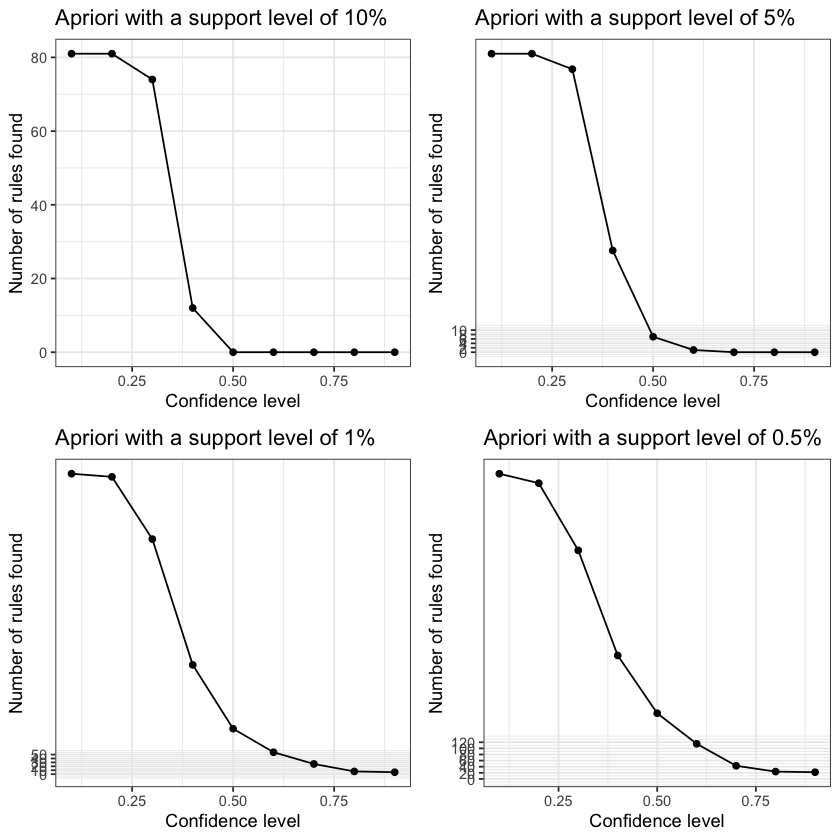
# Data frame
num_rules <- data.frame(rules_sup10, rules_sup5, rules_sup1, rules_sup0.5, confidenceLevels)
# Number of rules found with a support level of 10%, 5%, 1% and 0.5%
ggplot(data=num_rules, aes(x=confidenceLevels)) +
# Plot line and points (support level of 10%)
geom_line(aes(y=rules_sup10, colour="Support level of 10%")) +
geom_point(aes(y=rules_sup10, colour="Support level of 10%")) +
# Plot line and points (support level of 5%)
geom_line(aes(y=rules_sup5, colour="Support level of 5%")) +
geom_point(aes(y=rules_sup5, colour="Support level of 5%")) +
# Plot line and points (support level of 1%)
geom_line(aes(y=rules_sup1, colour="Support level of 1%")) +
geom_point(aes(y=rules_sup1, colour="Support level of 1%")) +
# Plot line and points (support level of 0.5%)
geom_line(aes(y=rules_sup0.5, colour="Support level of 0.5%")) +
geom_point(aes(y=rules_sup0.5, colour="Support level of 0.5%")) +
# Labs and theme
labs(x="Confidence levels", y="Number of rules found",
title="Apriori algorithm with different support levels") +
theme_bw() +
theme(legend.title=element_blank())
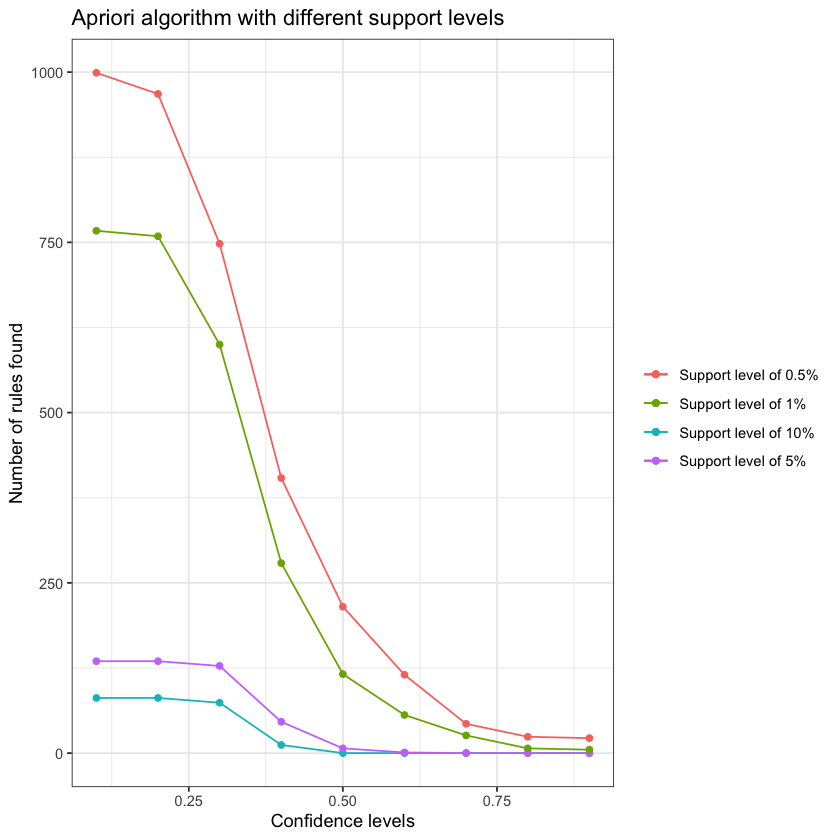
4. cSPADE algorithm with arulesSequences¶
Frequent Sequence Mining is used to discover a set of patterns shared among objects which have between them a specific order. For instance, students could enroll in multiple courses over different semester. In this case, we may use Frequent Sequence Mining to find that 40% of the students who enrolled in the STAT101 in term 1, continued to enroll in STAT 201 in term 2.
# create data semester 1
dt1 <- data.frame(matrix(ncol = 2, nrow = 1000))
colnames(dt1) <- c("sequenceID","item")
set.seed(123)
dt1$sequenceID <- sample(x=1:250,1000,replace = T)
set.seed(123)
dt1$item <- sample(x=c("PSY","MATH","STATS","ECON"),1000,replace=T)
dt1$eventID <- 1
dt1 <- unique(dt1)
# create data semester 2
dt2 <- data.frame(matrix(ncol = 2, nrow = 1000))
colnames(dt2) <- c("sequenceID","item")
set.seed(123)
dt2$sequenceID <- sample(x=1:250,1000,replace = T)
set.seed(123)
dt2$item <- sample(x=c("STATS","ECON","PHY","ENG","POLS"),1000,replace=T)
dt2$eventID <- 2
dt2 <- unique(dt2)
# # create data semester 3
dt3 <- data.frame(matrix(ncol = 2, nrow = 1000))
colnames(dt3) <- c("sequenceID","item")
set.seed(123)
dt3$sequenceID <- sample(x=1:250,1000,replace = T)
set.seed(123)
dt3$item <- sample(x=c("PHY","ENG","POLS","BIO","CHEM"),1000,replace=T)
dt3$eventID <- 3
dt3 <- unique(dt3)
dt <- rbind(dt1,dt2,dt3)
dt <- dt %>% arrange(sequenceID, eventID)
head(dt)
| sequenceID | item | eventID | |
|---|---|---|---|
| <int> | <chr> | <dbl> | |
| 194 | 1 | ECON | 1 |
| 1941 | 1 | STATS | 2 |
| 1942 | 1 | PHY | 3 |
| 356 | 2 | ECON | 1 |
| 852 | 2 | MATH | 1 |
| 3561 | 2 | ENG | 2 |
dt <- dt %>% group_by(sequenceID, eventID) %>%
summarise(item = paste0(item, collapse = ","),size = n())
dt <- dt %>% select(sequenceID,eventID,size,item)
head(dt)
`summarise()` has grouped output by 'sequenceID'. You can override using the `.groups` argument.
| sequenceID | eventID | size | item |
|---|---|---|---|
| <int> | <dbl> | <int> | <chr> |
| 1 | 1 | 1 | ECON |
| 1 | 2 | 1 | STATS |
| 1 | 3 | 1 | PHY |
| 2 | 1 | 2 | ECON,MATH |
| 2 | 2 | 2 | ENG,POLS |
| 2 | 3 | 2 | BIO,CHEM |
library(arulesSequences)
write.table(dt, "course_term.csv", sep=";", row.names = FALSE, col.names = FALSE, quote = FALSE)
trans_matrix <- read_baskets("course_term.csv", sep = ";", info = c("sequenceID","eventID", "size"))
summary(trans_matrix)
Warning message in type.convert.default(X[[i]], ...):
“'as.is' should be specified by the caller; using TRUE”
transactions as itemMatrix in sparse format with
738 rows (elements/itemsets/transactions) and
291 columns (items) and a density of 0.003436426
most frequent items:
ECON ENG PSY,ECON STATS STATS,PSY (Other)
15 15 14 13 13 668
element (itemset/transaction) length distribution:
sizes
1
738
Min. 1st Qu. Median Mean 3rd Qu. Max.
1 1 1 1 1 1
includes extended item information - examples:
labels
1 BIO
2 BIO,CHEM
3 BIO,CHEM,ENG
includes extended transaction information - examples:
sequenceID eventID size
1 1 1 1
2 1 2 1
3 1 3 1
# Get frequent sequences and corresponding support values
s1 <- cspade(trans_matrix, parameter = list(support = 0.02), control = list(verbose = F))
s1.df <- as(s1, "data.frame")
summary(s1)
inspect(head(s1))
set of 55 sequences with
most frequent items:
PHY PHY,POLS POLS ENG BIO (Other)
3 3 3 3 2 54
most frequent elements:
{ENG} {PHY} {PHY,POLS} {POLS} {BIO} (Other)
3 3 3 3 2 54
element (sequence) size distribution:
sizes
1 2
42 13
sequence length distribution:
lengths
1 2
42 13
summary of quality measures:
support
Min. :0.02033
1st Qu.:0.02033
Median :0.02439
Mean :0.02905
3rd Qu.:0.03252
Max. :0.06098
includes transaction ID lists: FALSE
mining info:
data ntransactions nsequences support
trans_matrix 738 246 0.02
items support
1 <{BIO}> 0.03252033
2 <{CHEM}> 0.02845528
3 <{CHEM,BIO}> 0.02032520
4 <{CHEM,PHY}> 0.02032520
5 <{ECON}> 0.05284553
6 <{ECON,MATH}> 0.03252033
#Convert Back to DS
itemsets_df <- as(s1, "data.frame") %>% as_tibble()
library(tidyverse)
#Top 10 Frequent Item Sets
itemsets_df %>%
slice_max(support, n = 10) %>%
ggplot(aes(x = fct_reorder(sequence, support),
y = support,
fill = sequence)) +
geom_col() +
geom_label(aes(label = support %>% scales::percent()), hjust = 0.5) +
labs(x = "Site", y = "Support", title = "Most Frequently Visited Item Sets",
caption = "**Support** is the percent of segments the contain the item set") +
scale_fill_discrete(guide = F) +
scale_y_continuous(labels = scales::percent,
expand = expansion(mult = c(0, .1))) +
coord_flip() +
cowplot::theme_cowplot()
Warning message:
“It is deprecated to specify `guide = FALSE` to remove a guide. Please use `guide = "none"` instead.”
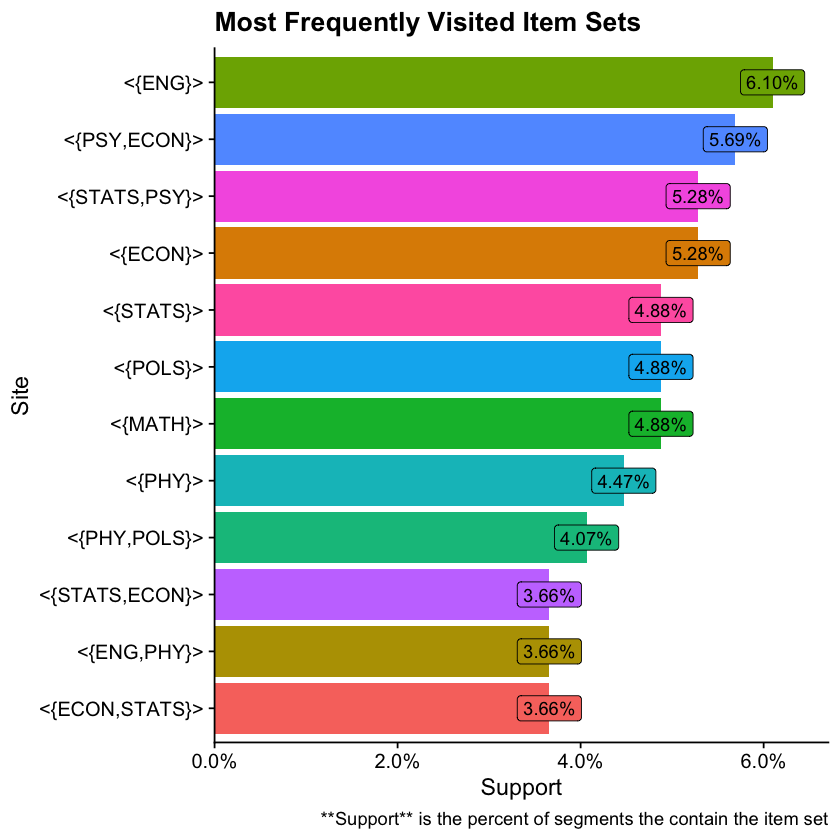
rules <- ruleInduction(s1,
confidence = 0.01,
control = list(verbose = FALSE))
inspect(head(rules, 5))
lhs rhs support confidence lift
1 <{PHY,POLS}> => <{POLS,CHEM}> 0.0203252 0.5000000 24.600000
2 <{PHY}> => <{POLS}> 0.0203252 0.4545455 9.318182
3 <{STATS,PHY,ENG}> => <{PHY,POLS,BIO}> 0.0203252 1.0000000 49.200000
4 <{STATS,PHY}> => <{PHY,POLS}> 0.0203252 1.0000000 24.600000
5 <{STATS,POLS}> => <{PHY,CHEM}> 0.0203252 1.0000000 49.200000
rules_cleaned <- rules[!is.redundant(rules)]
rules_df <- as(rules_cleaned, "data.frame") %>%
as_tibble() %>%
separate(col = rule, into = c('lhs', 'rhs'), sep = " => ", remove = F)
rules_df %>%
arrange(-confidence) %>%
select(lhs, rhs, support, confidence, lift) %>%
head() %>%
knitr::kable()
|lhs |rhs | support| confidence| lift|
|:-----------------|:----------------|---------:|----------:|-----:|
|<{STATS,PHY,ENG}> |<{PHY,POLS,BIO}> | 0.0203252| 1.0000000| 49.20|
|<{STATS,PHY}> |<{PHY,POLS}> | 0.0203252| 1.0000000| 24.60|
|<{STATS,POLS}> |<{PHY,CHEM}> | 0.0203252| 1.0000000| 49.20|
|<{ECON,PHY}> |<{ENG,POLS}> | 0.0243902| 1.0000000| 30.75|
|<{POLS,STATS}> |<{CHEM,PHY}> | 0.0203252| 1.0000000| 49.20|
|<{POLS,ENG}> |<{CHEM,BIO}> | 0.0203252| 0.8333333| 41.00|